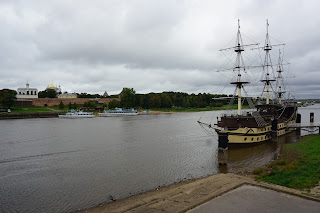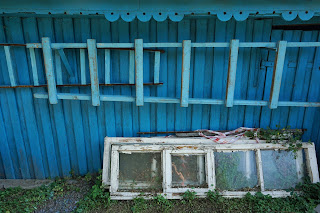September
is generally a beautiful month in Russia, we didn't want to waste a
moment of it. After the success of our day trip too Dubosekovo and
Volokolamsk, we planned another day trip for the Saturday of the next
weekend.
Kolomna
was our next destination. It is a city of a shrinking population,
like many cities within short distances of Moscow. Back at the end of
the 80s, the population was 161,000 or so, now it is 145,000. The
decline has been steady, but I don't expect it to stop. I get the feeling most of the towns and cities not too far from Moscow have the same problems with declining populations.
The
history of Kolomna is generally recognized as starting in the 12th
century, and has always been a part of the Moscow oblast
administration. Empress Catherine 2nd, otherwise known as
Catherine the Great.
We met
early Saturday morning at Elektrozavodskaya metro station, one of the
more photogenic stations, then found the suburban station above
ground to catch our train. We started our visit by taking a team
photo, as there was a great city sign in a tiny field located right
next to the train station. Big letters, each of us was able to stand
in or next to one of them.
We
started walking, intending to get to a church we had seen while the
train was coming into town. It didn't really work out that way at
all, whoops. First, we found the wrong church on the map, and ended
up there instead. It was closed, but we were able to wander the
grounds a bit and enjoy the beautiful wood roof.
We
also found a platz of sorts, for some reason there was a giant
samovar in one area of the platz. In another part of the platz was an
adult sized playground type slide. I have no idea why either one of
them were there, and we didn't see anyone else around.
As we
walked through town we saw quite a few windows with rearview mirrors
mounted outside the windows. Another mystery of the town of Kolomna,
we had no idea what purpose these mirrors served. They were literally
rearview mirrors taken off cars and mounted on the houses!
One
house was particularly interesting in that it had fake birds mounted
on the gutter and on the roof. Another house had toys in one of the
windows and a shed covered in toys. Kolomna is definitely on the list
as a quirky town.
We
finally found the church we'd intended to see first. The bell tower
was painted with blue and white stripes, the rest of the church was
painted blue.
Go figure, we stumbled into a funeral, whoops!!! As
soon as we figured that out we backed out of the church as fast as
possible, and left the property. We wanted to come back later in the
day, but ended up running out of time.
We
made our way in the direction of the kremlin, realizing as we got
there that the river was nearby, and a bridge over the river was
currently pulled back to let a boat go through. I was more keen to
see it come back together than Claire and Angela, so they stood back
while I tried to get closer.
It wasn't very exciting, but I like
bridges, so seeing the halves of the bridge come together was nifty.
We
went through the main tower gate of the kremlin, though it didn't
really feel as if we were inside a kremlin at that point. We could
see a few houses, and streets in a few directions. Clearly the
kremlin had walls around a large area, but the fortress section was a
lot smaller.
As we
were walking, we realized we'd stumbled on another surprise: a road
race. Police had blocked off several roads, and were telling people
to cross streets quickly or stay back as the runners came by. Maybe I
can run this race next year?
We
watched many of the runners go by, I think we were near the beginning
of the course. Near our viewpoint we found the main square of the
kremlin. Along the sides of the platz were three churches and a
school. Well, to be correct there were two churches, a school, and a
monastery. We entered the largest church first.
The
frescoes were beautiful, as was the light streaming into the windows
on one side.I practiced a lot of patience waiting for the photo I
wanted to take. The second church was nice as well, but not as
brightly coloured, and the ceiling was a lot lower.
From
there we crossed into the monastery, which I think was actually a
convent. I don't think there is a word for convent in Russian, the
signs always say something like monastery for women. There was a
yellow bell tower standing by itself in one corner, accomodation, and
a couple churches. One of them was smaller so it was probably just a
chapel. The other one was brightly coloured, it made me think Disney
had done the decoration. I'd describe the church architecture as
Disney on stilts, if that makes any sense. Go figure, the upper level
had nothing to see, and only the bottom level was open, and the
interior was not very exciting.
This
convent also had a tall yellow bell tower, set apart from each of the
churches.
We
left the convent and walked toward the kremlin.
(Remember, a kremlin
is a fortress, not just the most famous kremlin in Moscow.) Though it
should've been obvious, it wasn't so easy for us to find the walls of
the kremlin. When we did find them, it was clear they had been fixed
up somewhat recently.
We
crossed the walls, which were surrounded by a moat of sorts,
(currently empty,) then went through part of town. At that point we
were all thirsty, so our focus was in finding a cafe or supermarket
for drinks. We ended up settling on a supermarket, nearly chugging
our drinks. Not too far from the supermarket was a Lenin statue.
Feeling
better, we headed back toward the kremlin area. We found the corner
tower of the walls, and headed back 'inside.' This brought us to
another convent (female monastery,) in which we saw nuns in their
regular every day life a bit as we peeked through open doors on our
way to the church sanctuary. I'm not used to seeing the every day
life of nuns or monks, it was kinda neat.
On the
other side of the walls was a statue of a guy on a horse, a typical
statue for just about any city in Europe or South America.
At
that point we felt as if we'd seen nearly everything we wanted to see
in town. It didn't take long to find a bus stop where we could hop on
a bus to get us to our last sights. I wanted to walk, but the girls
were a bit tired. (To be fair, we had walked quite a way, and it was
only our second weekend of travel, so no one was in shape yet.)
The
bus was supposed to follow a main street, which ended up being
blocked off. The detour was a bit unnerving, but ended up being okay.
We were able to hop off and see a locomotive on permanent display.
Our
last sight wasn't far from the locomotive. There is a war museum in
Kolomna, with some military hardware on display in front of the
building. Not surprisingly, there was also a WW2 war memorial. This
one was a bit different in that there was a GIANT head of a soldier
as part of the memorial. The eternal flame was rather typical.
From
there it was easy to catch a tram (I love trams most of all public
transport,) back to the train station. We got really lucky with
timing, the next train back to Moscow left in 15 minutes or so. Woo
hoo for another great day trip.

















































